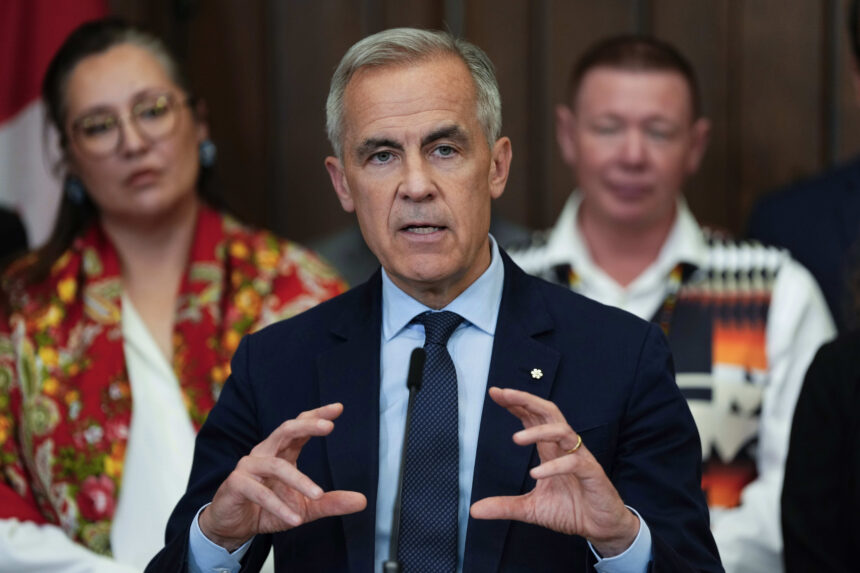Article – The passage of Prime Minister Mark Carney’s signature economic legislation has set off a firestorm of criticism from environmental groups and Indigenous communities across Canada. After months of heated debate, Bill C-97—the Major Projects Acceleration Act—received royal assent yesterday evening.
“This legislation fundamentally rebalances how Canada approves critical infrastructure,” Carney told reporters on Parliament Hill. “We cannot build the clean economy of tomorrow if it takes a decade to approve a transmission line or mine that will supply critical minerals.”
The new law creates a single-window approval process for projects deemed “nationally significant” and imposes strict timelines for environmental assessments. Government officials claim this will cut average approval times from seven years to less than two.
But the legislation has deeply divided Canadians. Standing outside the Senate following the final vote, Climate Action Network Canada spokesperson Jennifer Morrison didn’t mince words.
“They’ve essentially created a rubber stamp for fossil fuel expansion under the guise of clean energy transition,” Morrison said. “The fine print reveals frightening shortcuts around environmental protections that took generations to establish.”
The controversy centers on provisions allowing cabinet to designate projects that can bypass certain review requirements. Industry groups have championed these measures as necessary to compete globally.
“Look at Australia and their critical minerals strategy. Look at American investments flowing south. We’re playing catch-up,” said Dominic LeBlanc, Minister of Natural Resources, during final debate.
At Prosperity Mining’s headquarters in Vancouver, CEO Richard Thomson expressed optimism about the company’s stalled copper project in northern British Columbia. “We’ve been stuck in regulatory limbo for nearly five years. This clarity means we can finally move forward with hiring and investment.”
But Assembly of First Nations National Chief Cindy Woodhouse called the legislation “a significant step backward” in Crown-Indigenous relations. “Meaningful consultation isn’t something you can schedule into a 180-day timeline,” she noted during a press conference in Winnipeg.
The legislation passed 172-151 in the House of Commons last month, with the NDP opposing the government despite their supply-and-confidence agreement. Conservative leader Pierre Poilievre, whose party supported the bill, criticized it as “too little, too late” while claiming credit for pushing the Liberals toward streamlining approvals.
“Only after watching investment flee to the United States did Carney’s government copy our plan,” Poilievre told supporters at a rally in Edmonton last week.
Data from Statistics Canada shows foreign direct investment in Canadian resource projects dropped 37% between 2018 and 2023. The Business Council of Canada estimates regulatory delays cost the economy approximately $34 billion annually in unrealized economic activity.
The government has promised robust environmental protection despite faster timelines. Environment Minister Steven Guilbeault insists the legislation maintains Canada’s climate commitments. “We’re not lowering standards, we’re eliminating redundancies,” he said during committee hearings in April.
Critics point to a little-discussed clause allowing automatic approval if agencies miss deadlines. University of Victoria environmental law professor Patricia Davidson calls this the bill’s “most dangerous provision.”
“When regulators face impossible timelines with insufficient resources, projects will default to approval regardless of environmental impact,” Davidson explained in an interview. “That’s not streamlining; it’s bypassing science-based decision making.”
In Timmins, Ontario, where several critical mineral projects await approval, Mayor Michelle Taylor sees both opportunity and concern. “We desperately need these jobs and investment,” she told me during a recent community forum. “But our citizens also deserve clean water and meaningful involvement in decisions affecting their backyard.”
The legislation arrives as Carney’s government attempts to balance ambitious climate targets with economic growth. Since taking office in February, his approval ratings have steadily declined amid criticism that he’s too aligned with Bay Street interests.
Recent polling by Angus Reid shows 56% of Canadians support streamlining approval processes, but 61% worry about potential environmental consequences. This tension reflects Canada’s ongoing struggle to reconcile resource development with climate commitments.
“The real test isn’t passing this bill—it’s what happens next,” says economist Sherry Cooper. “Will we see responsible development or a race to the bottom? That’s what Canadians are watching for.”
The first major test case may come soon. Trans Mountain Pipeline has already applied to have its proposed expansion designated under the new act. Environmental groups promise legal challenges, arguing the legislation violates constitutional duties to Indigenous peoples.
Meanwhile, provincial reactions have varied dramatically. Alberta Premier Danielle Smith called the legislation “a welcome step toward sanity,” while Quebec’s François Legault raised concerns about federal overreach into provincial jurisdiction.
As federal officials prepare implementation guidelines, uncertainty remains about which existing projects might qualify for expedited treatment. The legislation creates a five-person advisory panel to recommend designations, but final decisions rest with cabinet.
For communities like Fort Nelson First Nation in northeastern British Columbia, where several energy projects intersect their traditional territory, the legislation brings more questions than answers.
“We’ve spent years developing our own consultation protocols,” said Councillor Sharleen Gale. “Now we’re told those timelines don’t work anymore. That’s not reconciliation.”
As Carney’s government moves to implement its signature economic policy, the true impact remains uncertain. What’s clear is that the battle over Canada’s resource development landscape has entered a new chapter—one that may ultimately be decided in courtrooms rather than the House of Commons.






